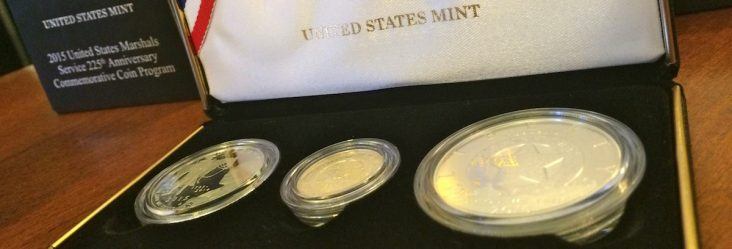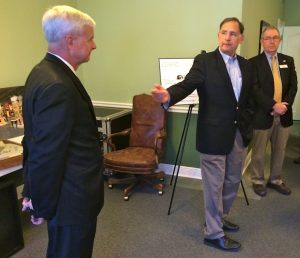Marshals Museum boss talks about fundraising ‘anxiety,’ says incoming president has the needed skills
by June 16, 2016 8:31 am 232 views

U.S. Marshals Service 225th Anniversary Commemorative Coins
Outgoing U.S. Marshals Museum President and CEO Jim Dunn acknowledged “anxiety” in the community about fundraising efforts for the planned museum, and said the incoming president has the professional background to get the museum off to a good start.
The museum board on Tuesday (June 14) approved the hiring of Patrick Weeks to be the third museum boss since 2007 when Fort Smith was selected by the U.S. Marshals Service to be home for the national museum. Weeks, 47, has more than two decades of experience in the creation and operations of guest experiences, environments and programming for museums, science centers and theme parks. He is the principal of Strategic Experience Solutions, which focuses on project planning; implementation and oversight; growth and development of operations; annual budgets; and guest experiences.
In an interview with Talk Business & Politics after Tuesday’s board meeting, Dunn said Weeks will be the first CEO with broad museum background experience. Dunn said as things progressed toward construction he knew someone with more experience in design, construction and operations was needed.
“I began getting this knawing feeling in the pit of my stomach that I couldn’t guide the museum with the skill sets that I have. … So it was a natural for me to take off one of my hats. I’ve taken off, or will take off, the operations hat and I’ll keep the fundraising hat,” Dunn said.
Of Weeks, Dunn noted: “I don’t think I’ve ever seen anyone as enthusiastic to take a job as he is. … I’m handing this off to him because he can take what we’ve done so far and make your children and you have fun. That’s what he does. I’m thrilled that he is as enthusiastic as he is to get down here.”
Dunn said one of Weeks’ first jobs is to understand the museum structure.

“He needs to immerse himself in all the drawings, the architectural drawings, all the design drawings so he will be thoroughly familiar with those on day one. We’re not so far along that he can’t pick it up pretty easily with his background. He’ll be a quick study,” he said.
FUNDRAISING ‘ANXIETY’
Raising more than $55 million to build the planned facility and secure money for operations has been closely watched by those in the Fort Smith metro and others interested in seeing the museum open. Museum officials are shooting for an opening sometime in 2018.
The latest numbers from museum officials shows $29.531 million in “committed fundraising” with $4.279 million of that going toward operational costs, leaving $25.252 million toward future construction and other costs. The total campaign goal is $58.661 million, which includes an estimated $3.5 million for operational costs from present through year one of an opened facility.
Based on the calculations, Dunn and staff are challenged to raise more than $35.8 million for the museum effort. The museum also is re-evaluating the cost of construction, which may change the fundraising target.
Dunn said the museum was announced in 2007, but “focused” fundraising did not begin until 2010. And he does admit that meeting some community expectations with the fundraising pace has been a struggle.
“There are people in the community who, I don’t construe it as doubt, I construe as anxiety because they want it to happen. What appears to be a slow pace of fundraising is really not. We’ve been fundraising, I’ve been fundraising actively since 2010. There was some fundraising before that but it was not as focused as it was after that. And compared to other museums, we’ve done quite well,” Dunn said. “But we have not done what the community would like to do and that is to get the thing funded in three years and built. So, I recognize those expectations and it’s a burden, I’ll be honest with you, but we’ve got some things in process that I’m very hopeful about.”
Dunn said that while Weeks’ primary job will be with facility construction and operations, he will help with fundraising.
“What he can do that I cannot is help spin the dream in very specific ways. He can take an exhibit, and knowing the experiential nature of it he can say to a prospective donor, ‘Look, this is what this exhibit is going to look like and this is what you’ll get out of this.’ I can tell the stories … but he take experiences and translate them into terms that will, I think, excite prospective donors,” Dunn explained.
Dunn was uncertain how many years he would remain with the museum in his new fundraising role.
“I would like to say as long as necessary. … I will stay with the project until I feel like the job is done. That does not necessarily mean that all the money is raised, but it will mean that I will retire when I’m confident that we’ve got a museum built or will be built,” he said.
MUSEUM BACKGROUND, RECENT CHANGES
In January 2007, the U.S. Marshals Service selected Fort Smith as the site for the estimated 50,000-square-foot national museum. A ceremonial groundbreaking was held in September, and museum officials hope to have the facility open by late 2017.
The museum will contain three primary exhibition galleries, a temporary exhibits gallery, a Hall of Honor, and a National Learning Center to offer programs for students, adults, and families. The three galleries are: “Marshals Today,” an overview of the role of U.S. Marshals in contemporary society; “A Changing Nation,” telling key stories of U.S. Marshals history; and “Frontier Marshals,” bringing law to the ever-changing frontier.
While the core structure remains the same, a new site plan approved in late 2015 pulls the museum footprint away from the river’s edge, and incorporates a “water feature” over which a deck and a planned prominent roof spire will reach. A memorial recognizing the five civilized tribes settled in Oklahoma is planned for the south part of the museum footprint, with a trail to run from the front edge of the museum down to the Greg Smith Riverfront Trail now under construction along the Arkansas River.
Changes to the layout happened after a surprise easement revelation. In early 2014 it was learned the planned museum site near the Arkansas River in downtown Fort Smith may have to be changed because of an unknown easement issue. The problem arose when the Arkansas River navigation system was built and county real estate records were not property changed to reflect new easements. However, the U.S. Corps of Engineers agreed in early November to allow construction of the museum that crossed easement lines in some areas.
On Nov. 5, 2015, the museum signed an agreement with the Corps that allows work on the more than $50 million project on the 16.3-acre space donated by the Robbie Westphal family. The new site plan also has the museum on a 10-foot base that moves the museum out of the 100-year flood line and into a 500-year line.
